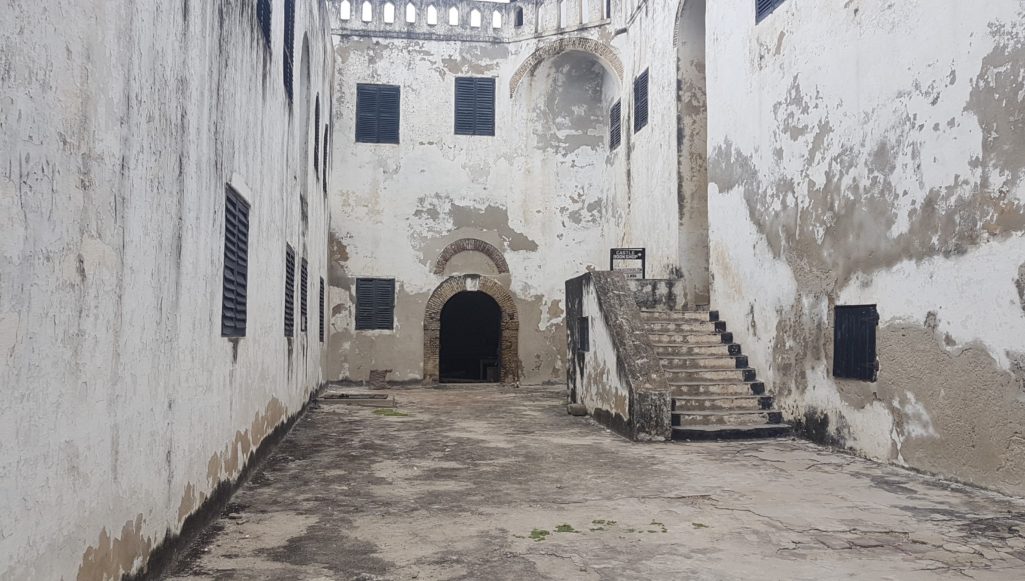Nelson Mandela once said, “when we decided to take up arms, it was because the only other choice was to surrender and submit to slavery “.
The Elmina castle also known as the St George castle, was built by the Portuguese in 1486, to serve as a source of protection for the people of Gold Coast.
To get the land for the building of the fort, a Portuguese trader, Azambuja, who had lived at Elmina for a while, was contracted to arrange and interpret an official meeting with the local chief, Kwamin Ansah (interpreted from the Portuguese, “Caramansa”). Hiding his self-interest with kind manners and friendliness, ‘Azambuja’ (a representative for the Portuguese), told the chief of the great benefits in building a fort, including protection from the very powerful king of Portugal.
During the meeting, Azambuja and Chief Kwamin Ansah both engaged in a great peace ritual that included a feast, musicians, and people from both Portuguese and the natives of Elmina.
Initially, Chief Kwamin Ansah, while accepting Azambuja, was wary of a permanent settlement as he should, but the hospitality of Ghanaians in him overcame the feeling of wariness.
After offering gifts, making promises, and hinting at the consequences of not complying, the Portuguese finally received Kwamin Ansah’s reluctant agreement.
When construction began the next morning, the chief’s reluctance was proved to be well needed. In order to build the fort in the most defensible position on the foreland, the Portuguese had to demolish the homes of some of the villagers, who consented only after they had been compensated.
The Portuguese also tried to quarry a nearby rock that the people of Elmina, believed to be the home of the god of the nearby River Benya. Before the demolition of the homes, Azambuja sent a Portuguese crew member, João Bernaldes with gifts to deliver to Chief Kwamin Ansah and the villagers. Azambuja sent brass basins, shawls, and other gifts in hopes of winning the goodwill of the villagers, so they would not be upset during the demolition of their homes and sacred rocks.
However, João Bernaldes did not deliver the gifts until after construction began, by which time the villagers became upset upon witnessing the demolition without forewarning or compensation. Retaliating, the locals staged an attack that resulted in the deaths of many Portuguese.
When they thought an understanding had been reached, continued opposition led to the Portuguese burning the local village in retaliation. Even in this tense atmosphere, construction of the first story of the tower was completed after only twenty days.
The remainder of the fort and an accompanying church was completed soon afterwards, despite resistance.
The new fort, signifying the permanent involvement of Europeans in West Africa, had a considerable good effect on Africans living on the coast. At the urging of the Portuguese, Elmina declared itself an independent state whose Governor then took control of the town’s affairs.
The people of Elmina were offered Portuguese protection against attacks from neighbouring coastal tribes, with whom the Portuguese had much less genial relations (even though they were friendly with the powerful trading nations in the African interior.) If any locals attempted to trade with a nation other than Portugal, the Portuguese reacted with aggressive force, often by forming alliances with the betraying nation’s enemies. Hostility between groups increased, and the traditional organization of native societies suffered, especially after the Portuguese introduced them to fire-arms, which made the dominance of the stronger nations easier.
Needless to say, the people of Elmina did not enjoy ‘happily ever after’. The beginning of the slave trade in Gold Coast, now Ghana, led to the use of the fort as a passageway for slaves to go through before the final sale to the Whites.
The fort had no water or sanitation, the floor of the dungeon was littered with human waste and many captives fell seriously ill. The men were separated from the women, and the captors regularly raped some of the helpless women. The castle also featured confinement cells — small pitch-black spaces for prisoners who revolted or were seen as rebellious. Once the slaves set foot in the castle, they could spend up to three months in captivity under these dreadful conditions before being shipped off to the New World.
Today, if some Africans are generally hostile towards the Whites, one should hardly blame them, for there once was a time when they were defenceless against the slave trade in the land they could no longer call their own.
But as Mandela said, It is necessary to heal the wounds of the past If you are going to build your country and to have unity. I am working with people who fought me very bitterly before the elections. It was my responsibility as the man who is leading the majority party, my responsibility to heal the wounds of the past and to work with people who were my opponents.
REFERENCES
Available at easytrackghana.com
Written by: Cha Cha Esi Asantewaa


